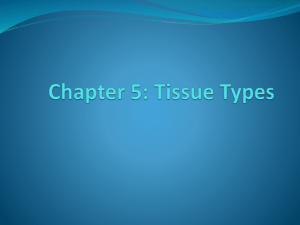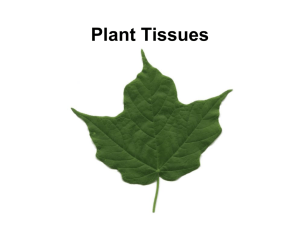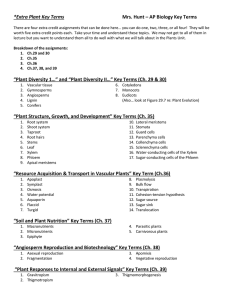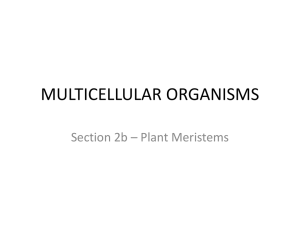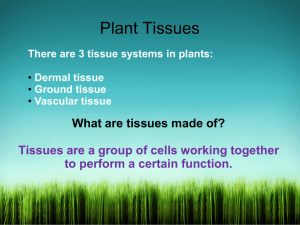Plant Tissues - 1
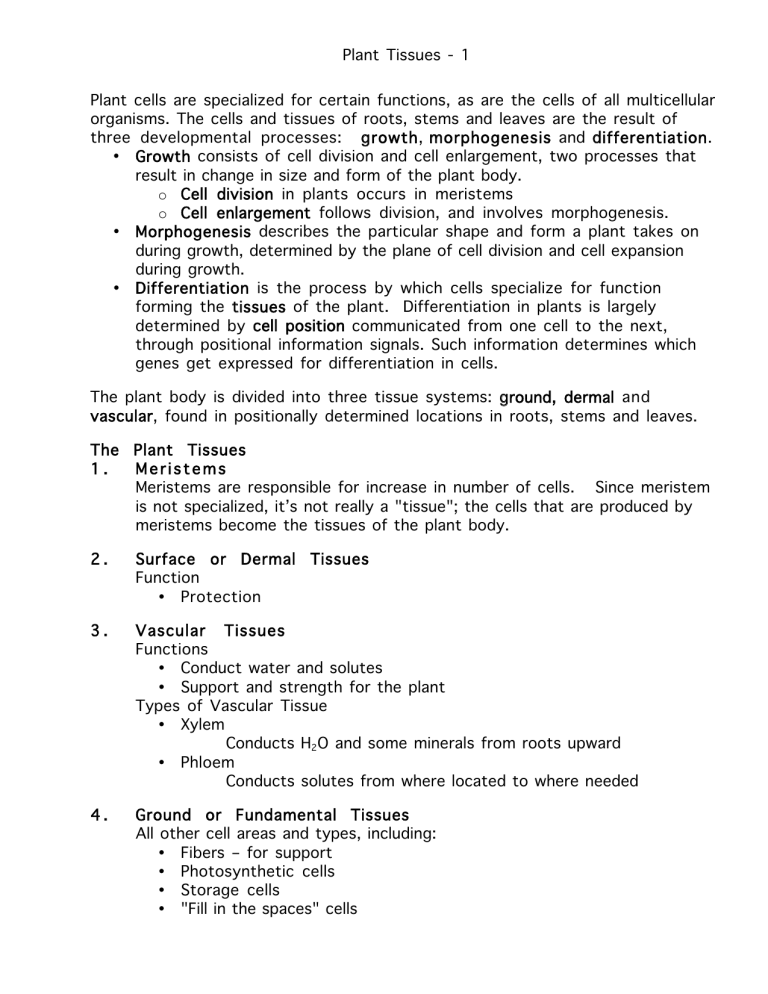
Plant Tissues - 1
Plant cells are specialized for certain functions, as are the cells of all multicellular organisms. The cells and tissues of roots, stems and leaves are the result of morphogenesis and ddifferentiation.
•
Growth consists of cell division and cell enlargement, two processes that result in change in size and form of the plant body.
o Cell division in plants occurs in meristems o Cell enlargement follows division, and involves morphogenesis.
•
Morphogenesis describes the particular shape and form a plant takes on during growth, determined by the plane of cell division and cell expansion during growth.
•
Differentiation is the process by which cells specialize for function forming the ttissues of the plant. Differentiation in plants is largely determined by ccell position communicated from one cell to the next, through positional information signals. Such information determines which genes get expressed for differentiation in cells.
The plant body is divided into three tissue systems: gground, dermal and vascular, found in positionally determined locations in roots, stems and leaves.
The Plant Tissues
1 .
M e r i s t e m s
Meristems are responsible for increase in number of cells. Since meristem is not specialized, it’s not really a "tissue"; the cells that are produced by meristems become the tissues of the plant body.
2 .
Surface or Dermal Tissues
Function
•
Protection
3 .
Vascular Tissues
Functions
•
Conduct water and solutes
•
Support and strength for the plant
Types of Vascular Tissue
•
Xylem
Conducts H
2
O and some minerals from roots upward
•
Phloem
Conducts solutes from where located to where needed
4 .
Ground or Fundamental Tissues
All other cell areas and types, including:
•
Fibers – for support
•
Photosynthetic cells
•
Storage cells
•
"Fill in the spaces" cells
Plant Tissues - 2
Organization of Tissues
Although we will discuss each of the plant tissue types, their constituent cell types, and the meristems from which they are derived, it is useful to first revisit the organization of tissue systems in the plant organs that relate to the primary derivative meristems in the embryo.
M e r i s t e m s
Plant cell division occurs in m embryo shoot tip (epicotyl) and root tip (radical) are retained throughout the life of the plant, and apical meristems and their derivatives, found in various places of the plant, are responsible for plant growth.
Plant Tissues - 3
Recall that plant growth occurs along an axis that increases in "length". Growth in length is pprimary ggrowth, and is produced by pprimary meristems. The radial pattern of growth: epidermis, ground tissue and vascular tissues, as shown by cross sections of plant regions, is also determined in the embryo by the radial pattern of the derivative meristems.
Growth that increases the girth or circumference of the plant is the result of secondary meristems, and is called ssecondary growth. Not all plants have secondary growth. Herbaceous plants that we call herbaceous plants have little or no secondary growth. Most monocots do not have secondary growth.
Primary meristems
Found at growing tips of plants
•
Shoot tip meristems (form shoot system)
Stem meristem
Leaf primordia
Bud primordia
•
Root tip meristems (form root system)
Shoot Meristem Root Meristem
Primary meristems are permanent and self-perpetuating. They consist of the meristem iinitials and the dderivatives. As meristem initials divide, they produce derivative meristems from which the tissue systems of the plant are formed.
Primary Derivative Meristems
•
P r o t o d e r m
Develops into surface or dermal tissues, the epidermis
•
Procambium
Develops into vascular tissue of primary growth including xylem and phloem
•
Ground meristem
Produces fundamental or ground tissues, including parenchyma, collenchyma and sclerenchyma
We will discuss how the derivative meristems specialize in more detail when we discuss root structure and shoot structure.
Plant Tissues - 4
Secondary Meristems
Many plants increase in girth (diameter), developing wood and bark. This growth is known as ssecondary growth. These tissues do not develop from regions of primary meristems but develop from special secondary (lateral) meristems (that are derived from the primary procambium or by dedifferentiation of primary tissue).
•
Vascular cambium
Produces wood (strength)
Produces part of bark (protection)
•
Cork cambium
Produces protective layer of bark called cork
Meristems from Cell Dedifferentiation
Any living plant cell has the ability to ddedifferentiate – to become a meristematic cell – and begin growth processes anew. In fact, some natural and normal growth patterns require dedifferentiation, such as:
•
Lateral root formation
•
Adventitious growth (growth from a plant organ other than “self”)
•
Wound healing
•
Secondary cork cambium
Most meristems that arise from dedifferentiation are functionally primary meristems. Cork cambium is, however, a secondary meristem.
Several plant propagation techniques, such as cloning, cuttings and layering, take advantage of dedifferentiation to grow needed organs.
Plant Tissues - 5
Ground or Fundamental Tissues (from gground meristems)
1 .
Parenchyma - basic tissue type
•
Produced from ground meristem
•
Locations
•
Cortex
Pith
Leaf mesophyll |
Fruit "flesh"
Vertical strands in primary vascular tissue
Horizontal rays in secondary vascular tissue
•
Description:
Alive at maturity
Uniformly thin-walled (generally primary wall only)
Many shapes and sizes
Often are "loosely" packed, with surrounding air spaces
May divide (retain their meristematic capability)
Initiate wound healing
Initiate adventitious structures by dedifferentiation
•
Functions
•
Photosynthesis (Called cchlorenchyma because cells contain chloroplasts)
•
Buoyancy, (Called aaerenchyma as in floating leaves that have huge air spaces
•
Storage (May contain a number of substances)
2
O movement in secondary growth (ray cells)
•
Transverse H
•
Transfer cells. Transfer cells have wall ingrowths (invaginations) that increase surface area. Transfer cells help move solutes across short distances. They are often found in veins, leaf traces, and reproductive structures. Secretion cells that line ducts and glands (nectar, oils, gums, hormones) are transfer cells.
Parenchyma cells
Plant Tissues - 6
2 .
Collenchyma
•
Locations
Borders veins of dicot leaves
Lines stem and petiole epidermis
•
Description
Elongated
Uneven primary wall thickenings
Alive at maturity
•
Function
Provides flexible support
Collenchyma in celery rib Collenchyma tissue adjacent to epidermis
3 .
Sclerenchyma
•
Locations
Anywhere in plant
•
Function
Support
Strength
•
Description
Thickened secondary walls with llignin
Narrow diameter (lumen)
Generally non-living at maturity (Function dead)
•
Types
S c l e r i d s
Short and can be in many shapes
May be single or in aggregates
Sclerids are common in seed coats and nutshells
Stellate sclerid Stone cells
Plant Tissues - 7
F i b e r s
Elongated and slender
Generally in bundles or strands
Most plant fibers of economic value are indeed, fibers.
Fibers: Cross-section Longitudinal sections
Plant Tissues - 8
Vascular Tissues
A complex tissue system produced from pprocambium in primary growth and from vascular ccambium in secondary growth
•
Functions
Conduction of water, solutes and some minerals throughout the plant
Support for the plant
Some food storage
•
Two types
Xylem
Phloem
Xylem
•
Moves H
2
O and some minerals uup through plant from roots to leaves
•
Xylem tissue is also used for food storage, especially in roots
•
The plant part that we refer to as w
•
Composed of “tracheary elements” wood is xylem tissue
Vessels (Vessel elements)(Only in Angiosperms and Gnetophytes)
•
Elongated cells with secondary walls that connect to form tubes
•
Die at maturity (genetic aapoptosis)
•
End walls of vessels are perforated (literally no cell wall regions) Water moves more freely from cell to cell through the perforations
•
Generally fairly large diameter
•
Characterized by a variety of wall thickenings (rings, spirals, pitted, etc). Primary xylem that elongates more will have rings or spiral thickenings. Metaxylem and secondary xylem stretches less and is more rigid.
Vessels: Longitudinal section Cross section
Differentiation of vessel elements involves lateral expansion, helical secondary wall formation, lysing of the cell's cytoplasm and destruction of the primary cross walls at the perforation site.
Plant Tissues - 9
Tracheids (found in non-flowering vascular plants as well as in some
Angiosperms)
Elongated, usually narrow cells with secondary walls
Die at maturity
Walls are pitted to permit ease of water movement
Tracheids: Longitudinal section Bordered pits
Xylem Fibers (sclerenchyma)
Fibers are found throughout xylem to provide support
Xylem Parenchyma
Xylem rrays are parenchyma cells that conduct water laterally through wood
Xylem vessels move water more efficiently than tracheids but are more vulnerable to damage, particularly from air bubbles (embolisms) and freeze/thaw of water.
Plant Tissues - 10
Phloem
•
Moves solutes, especially carbohydrate, throughout the plant
•
Composed of sieve elements
Sieve cells (found in gymnosperms and non-seed vascular plants)
Narrow pores with uniform sieve areas in elongated cells.
Sieve tube elements (found in angiosperms)
•
Elongated cells form sieve tubes
•
End walls have larger pores forming sieve plates (which are not found in sieve cells)
•
Little cytoplasm at maturity, although sieve tubes retain a protoplast comprised of plasma membrane, much smooth
ER, mitochondria and plastids that line the wall. The nucleus, ribosomes, Golgi bodies, cytoskeleton and vacuole degenerate.
•
Sieve tube pores of damaged phloem are lined with ccallose, a spiral-shaped glucose polysaccharide.
•
Sieve tubes also have a protein (pp-protein or phloem protein, sometimes called slime, that originates as pprotein bodies. P-protein plugs sieve pores in damaged cells and is often conspicuous in prepared materials. P-protein and callose may function to protect the plant from loss of solutes in damaged phloem areas.
Companion cells
Parenchyma cells adjoining the sieve tube cells. Companion cells have many plasmodesmata connections to their adjacent sieve tubes. It is assumed that companion cells provide for the metabolic and energy needs of the sieve tube with which they are associated.
Albuminous cells
Parenchyma cells found in gymnosperms that are similar to companion cells.
Phloem Fibers (sclerenchyma cells)
Phloem parenchyma generally used for storage
Plant Tissues - 11
Dermal (Surface) Tissues
1 .
Epidermis layer – Primary Growth
•
Produced from protoderm in primary growth
Generally single layer thick (There are some exceptions, such as in air roots, which are called vvelamen, and some leaves of tropical plants, where the additional layers serve as sun screens)
•
Functions to protect from:
Mechanical damage
Water loss
Diseases and pests
•
Description
Outer wall thickened
Often have interesting and variable shapes
May be non-living at maturity
Cuticle (protective waxy layer) of ccutin secreted on surface on above ground parts which helps prevent water loss, and protects the plant from potential pathogens like bacteria
Some waxes are produced in quantities, and are used by humans commercially
2 .
Periderm or Cork
•
Produced from cork cambium and forms the ssecondary epidermis or periderm of woody plants
•
Comprises, with phloem, the "bark"
•
Functions for protection
•
Periderm consists of cork (or phellem), cork cambium and phelloderm
(parenchyma tissue interior to the cork cambium used for storage)
•
Cork cells are produced exterior to the cork cambium, die at maturity, and contain ssuberin (non water soluble material) in their walls.
•
Loose clusters of parenchyma cells are found within in the cork layer to permit gas exchange. These are called llenticels and are conspicuous in some species of trees.
•
Cork cambium is dedifferentiated from a number of parenchyma cells, but typically from stem cortex parenchyma.
Plant Tissues - 12
Lenticel
3 .
Epidermal modifications of note
•
Hairs or ttrichomes
Many types for many purposes
•
Root hairs: Absorption of H2O
•
Hairs on xeromorphic plants reflect sunlight, lowering temperature and reducing water loss
•
Some hairs on salt marsh plants secrete salt
•
Some hairs can absorb water and minerals on above ground parts of plants
•
Hairs may defend the plant against predators with barbs, traps, etc.
•
Guard cells
Form stomata for gas exchange (Contain chloroplasts)
•
Glands
Modified cells containing oils or other substances for secretion. Many glandular hairs contain toxins and irritants
Glandular Trichomes Branched Trichomes Stomata and Guard Cells Root Hairs
Plant Tissues - 13
Controlling Cell Growth and Development
Before we leave the discussion of tissues, you have learned that cell division in plants occurs in meristems and that plant cells in general have great genetic
"plasticity", which is a way of saying they retain genetic competency after specialization of cells.
Molecular biologists are studying the mechanisms of cell growth, expansion, morphogenesis and differentiation. Often they use Arabidopsis, for its genome is known and has only about 15,000 functional genes. Its small size and rapid life history make it ideal for such studies, just as the fruit fly was ideal for early studies on inheritance patterns.
Cell division in meristems increases the number of cells; cell expansion, following division, increases the plant's mass. We have already stated that plant development is determined by a cell's position in the derivative meristems: protoderm cells become epidermis, ground meristem cells become ground tissues and procambium cells differentiate into vascular tissues. Position of cells during mitosis is one of the determinants of growth. The symmetry of cell division is also important.
Role of Microtubules in Cell Orientation
The plane (or direction) of cell division is determined in late interphase. A set of microtubules located in the outer cytoplasm of a cell about to divide orients into a ring called the ppreprophase band. The preprophase band "imprints" the cell actin microfilaments to its plane of division. During mitosis, the microtubules disperse, but the microfilaments orient the nucleus of the cell until the spindle complex has arranged the chromosomes for metaphase. The imprinted actin microfilaments also determine the vesicle alignment for the cell plate formation.
Plant Tissues - 14
Preprophase Microtubule Band and Plane of Division
Cells that divide in one plane form a "file" or row of cells. Cells that divide in two or three planes form "cubes" of cells.
Cells that divide asymmetrically form unequal volume cells that may also subsequently change their plane of symmetry.
Cell expansion is similarly controlled, but uses the orientation of cellulose fibers in the wall to control the plane of expansion. Enzymes soften non-cellulose crosslinks in the cell wall to allow osmosis and turgor to exert pressure on the wall in the plane perpendicular to the cellulose fiber orientation in the cell wall. Microtubules in the outer cytoplasm determine the orientation of the cellulose microfibrils deposited in the cell walls.
Plant Tissues - 15
Arabidopsis "fass" mutants have been used to study the role of cytoplasmic microtubules in cell division orientation. Fass mutants are squat and disorganized with a seemingly random cell orientation. Fass mutants lack the preprophase band of microtubules, so the plane of division is random. The cellulose fibrils cannot orient for expansion and the entire plant becomes compact and disordered even as they develop into tiny adults.
Normal and Fass seedling Fass adult
Morphogenesis and Pattern Formation
Form and differentiation of cells in plants is dependent upon their position in the meristems. As organs develop from shoot and root meristems, this positional information is retained and gene activity varies in each cell depending on its location. Molecular biologists today are studying the role of specific pprotein and mRNA gradients that serve to orient differentiating cells. A substance diffusing from a shoot apex may signal other cells information about distance from the apex needed for differentiation. Radial position can be determined by radial diffusion from outermost cells.
Polarity, from the first division of the zygote, determines shoot versus root in the plant axis. Gradients can act differently in root and in shoot tissues. The roles of specific genes, including plant homeotic genes, are actively being investigated.
For example, homeotic genes control the degree of development of leaflets.
Multiple Leaflets caused by homeotic gene activity
Plant Tissues - 16
The expression of the GLABRA-2 homeotic gene controls root hair development.
Epidermal cells may contact one cortex cell or two cortex cells. The GLABRA-2 gene is not expressed in epidermal cells that border two cortex cells; those epidermal cells produce root hairs. The expression of the GLABRA-2 gene in cells that border just on cortex cell prevents root hair development.
Control of root hair formation
(Green cells cannot form root hairs)
Gnom mutant Arabidopisis
If the first division of the zygote in the gnom mutant Arabidopsis is not asymmetrical, the developing embryo lacks polarity, and forms a mass with no roots or leaves. This mutation is caused by the inability to transport the hormone, auxin in a polar direction.
The differentiation of juvenile and mature leaf patterns is also associated with gene controls. The juvenile line will be retained in areas of the plant even after the apical meristem will have undergone a "phase change" since each node has "unique" meristem.
As discussed in our section on flower structure, the same pattern genes differentially activate flower part differentiation. It is believed that selective transcription factors control the gene combinations for flower pattern.
Plant Tissues - 17
Summary of Tissues and Cell Types

